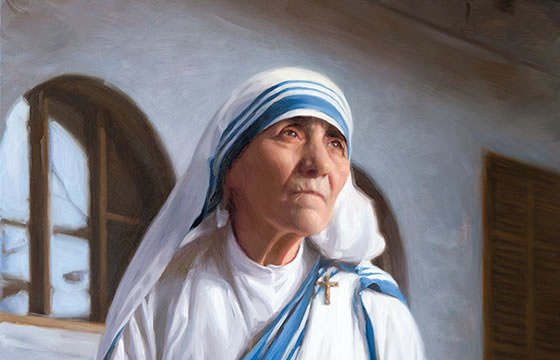 How does an artist capture the essence of someone like Mother Teresa of Calcutta? Jemimah McMurray talks to Paul Newton, whose painting of the newly canonised saint has been placed on display at Domus Australia in Rome.
How does an artist capture the essence of someone like Mother Teresa of Calcutta? Jemimah McMurray talks to Paul Newton, whose painting of the newly canonised saint has been placed on display at Domus Australia in Rome.
 The light falls softly on the strong woman standing in a hospital dorm. She looks into the distance while a malnourished man clutches her hand. A blue and white sari marks her as a Missionary of Charity, and the Rosary beads, a woman of prayer. The world knows her as Mother Teresa.
The light falls softly on the strong woman standing in a hospital dorm. She looks into the distance while a malnourished man clutches her hand. A blue and white sari marks her as a Missionary of Charity, and the Rosary beads, a woman of prayer. The world knows her as Mother Teresa.
‘People have told me they think it is beautiful’, Sydney artist Paul Newton says, ‘and I can see what they mean. But it’s almost beauty in defiance of the reality that she lived in. In Calcutta, working with these poor, destitute, dying people, the situation would have been awful.’
It was a Sunday afternoon when I met with award-winning portrait artist Paul Newton to discuss his latest work. We had found a small, quiet room to escape the bustle of coffee-drinkers and family lunchers after the midday church service. The father-of-four wore a navy-blue polo jumper and a kind smile, leaning forward to show me the masterpiece soon to be sent to Rome.
It was the dignity of the woman’s face that drew me in, the way it told of strength and sensitivity. ‘Beauty, in defiance’, he’d said. This fascinated me.
The portrait would be hung in the Domus Australia Chapel in Rome, as part of a series of 32 paintings commissioned by Cardinal Pell in 2010. I had been to that chapel just two years ago and seen some of the works. I recalled fondly its high ceilings, delicate stone-work and detailed paintings. The sequence of artworks alone had taken five years.
Paul flicked through his iPad Pro to show me the other works, including those of Our Lady of the Southern Cross, The Early Christians in Sydney, and Saint Mary of the Cross MacKillop.
‘This one of Mother Teresa will be displayed beside one of John Paul II, and they make the final two in the series. They’ll be always shown together, showing their connection as contemporaries and friends.’
The painting went on display just in time for the canonisation of Mother Teresa.
‘What I’d like to offer is a vision of Mother Teresa as a visionary, someone who was totally dependent on God for everything about her vocation and her work. She had so much difficulty establishing her order in the early days, yet she had a dogged determination, a vision for what she wanted to do and the dependence on God to help that happen.’
The original paintings are almost life-sized, in extraordinary detail. ‘She was not much over five feet tall, which belied the fact that she was such a giant in so many other ways.’
Paul points out Mother Teresa’s hands, one holding the Rosary beads and the other grasping the hand of the dying man.
‘That was what she was doing. She was taking the grace of God and passing it along to those around her. She was the conduit for God to love them, her brothers and sisters. She’s supporting the man, but she’s also looking beyond the man, to Christ.